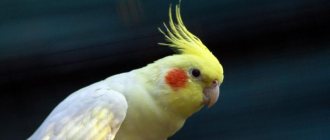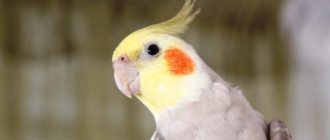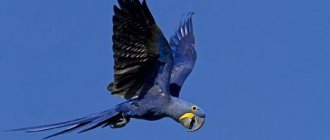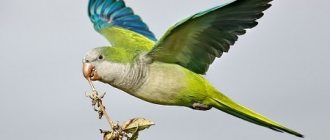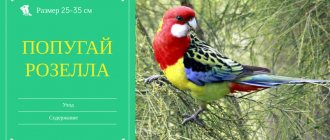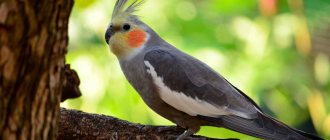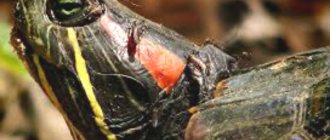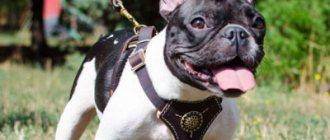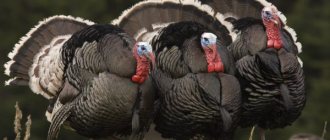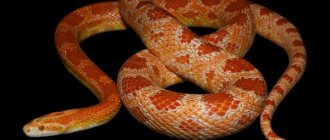Keeping at home
The extensive practical experience of numerous poultry farmers shows that caring for a Corella parrot at home is quite simple. You just need to adhere to some mandatory rules.
Cell selection
Corella is not a wavy bird, so it needs a fairly spacious place to keep it. The cage dimensions should be 40 x 50 x 100 cm per pet. The shape should be rectangular. The cage door must be equipped with a secure lock so that the bird cannot open it on its own. For owners of a private home with several parrots, it would be preferable to equip an aviary.
The cage should be made only from high-quality, durable and environmentally friendly materials. The quality of execution must be high.
There should be no small chips or burrs on its surface.
Home improvement
The following must be installed inside the cage:
- Drinkers in which the water needs to be changed every day, and in the summer this can be done twice or three times.
- Feeder (preferably more than one, so that only one type of food can be placed in one feeder, which is convenient for both the parrot and its owner)
- Bathing suit. This accessory is very important because the bird takes a bath there.
- Perches. It is better to make them from tree branches. But you can also buy ready-made ones in the store.
- Toys. These include ladders, swings, rope ropes, and bamboo rings.
- Devices for grinding beaks. It can be mineral stone or sepia.
Temperature and light conditions
The microclimate in the room where the Corella parrot is kept should resemble the natural conditions in its habitat - Australia. The air temperature should be from 18 to 25 degrees Celsius. The air humidity must be maintained at approximately 70%.
It is strictly not recommended to install the cage near heating devices. The room with the parrot must be regularly ventilated. It is necessary to prevent the parrot from being in a draft. The cage can be moved to another part of the room, less airy, or moved outside it.
The recommended sleep duration for birds in summer is at least 10-12 hours. In winter, it increases to 12-14 hours. Therefore, it is necessary to regulate the duration of daylight hours. In winter, the cage needs to be illuminated in the evening, when darkness has already set in. You can do this in the morning.
In summer, on the contrary, it is necessary to cover it with a cloth and create an artificial night so that the pet understands that it is time to sleep. If the owner regularly performs this activity, the bird will not wake him up in the morning with its singing. The Corella will sit calmly on her favorite perch.
Purity
Cockatiels leave quite a lot of trash behind. Therefore, their cages must be regularly cleaned and disinfected. The cage floor, feeder and water bowl should be washed daily. Perches and toys can be washed as they become dirty.
About once a week you need to disinfect the cage. This will be a good prevention of all kinds of diseases.
How to determine gender
The female differs from the male in the shade of her plumage. The spots on her head are not red, but brownish; the crest is not straw, but dirty yellow. Females have spots on the inside of their flight feathers. The tail feathers are paler than those of males and covered with black stripes.
How to determine age? The older the bird, the lighter its eyes. Young specimens have black pupils, while older specimens have gray pupils. The paws, beak and wax, on the contrary, darken with age. In young birds, the mandible, beak and claws are smooth with a gray tint, and there are almost no scales on the fingers. With age, the integument becomes coarser, the paws and claws become covered with scales.
The crest of chicks consists of straight feathers, while that of adults consists of curved feathers. The first change of feathers occurs at 6-8 months. After it, the plumage acquires the rich color typical of cockatiels. A bird purchased at a young age must moult from its new owner. If this does not happen, the cockatiel was more than 8 months old at the time of purchase.
The Corella parrot is a fun pet that can learn to talk and be trained. He needs standard care for parrots. Keeping this bird is accessible to everyone, regardless of knowledge of ornithology.
Diet
The cockatiel menu should be as close to natural as possible. This means that the diet should be dominated by:
Grain feed (millet, hemp seed, oats, corn, canary grass). The average rate of grain feed is 1.5-2 tablespoons daily. The last number is for a large parrot.
Vegetables (cucumbers, carrots, Brussels sprouts).
Fruits (Plums, apples, peaches, pears, cherry plums). The parrot is partial to these fruits.
In small quantities, you can add wheat grains, sunflower seeds, nuts and legumes soaked in water. Sometimes you can gradually give animal products - boiled eggs and low-fat cottage cheese. Birds especially need animal protein during nesting.
Prohibited Products
The list of foods that cockatiels should not eat includes:
- Candied fruits.
- Seeds of stone fruit crops.
- Hot peppers.
- Milk, cheese, butter, sour cream.
- Spices.
- Potato.
- Mushrooms.
- Branches of conifers, oak, viburnum, pear, lilac, poplar.
- Sorrel and rhubarb.
General health problems
The most common health problem in cockatiels is malnutrition. Too often they are fed only seeds.
They need the vitamins and minerals found in fruits, vegetables and a pellet-based diet to prevent malnutrition.
Cockatiels are prone to fatty liver disease, which occurs as a result of a high-calorie diet rich in carbohydrates and fats and limited or no exercise.
To reduce your cockatiel's risk of contracting this disease, make sure your bird has a varied diet and keep it away from insecticides, pesticide residues on fruits and vegetables, and cleaning product fumes.
Most birds are susceptible to respiratory disease and psittacosis, a dangerous bacterial infection that can cause respiratory symptoms such as wheezing, sneezing, coughing and nasal discharge. Take your bird to the veterinarian at the first sign of illness. Quick action can save your bird's life.
Emotional comfort
To successfully keep a cockatiel parrot at home, it is necessary to ensure maximum psychological comfort. You should never threaten your pet, grab it with your hands, or make sudden movements in front of its eyes. This will lead to a breakdown in contact with the bird. It will take quite a long time to restore it.
You should never force your parrot to leave its cage. If you need to catch him and return him to the bird house, this must be done as carefully as possible, avoiding harshness. You need to talk and play with your parrot regularly. It is important for him to perceive himself as part of the pack and to be needed by the owner and his family members.
If your parrot feels lonely, he may get sick and become depressed.
Bird care
One of the main responsibilities of a cockatiel owner is caring for the bird. It is as follows:
- feeding your pet healthy food;
- ensuring constant access to clean water;
- communication with birds;
- observing the psychological state of the bird, normally it should not bite or show other signs of aggressive behavior;
- maintaining the health of the parrot, identifying symptoms of diseases, and regular visits to the veterinarian.
Communication and training
How to quickly tame a cockatiel? The main rule here is regularity and gradualness. You can’t try to put a parrot on your hand right away. He will simply get scared and show aggression. You must gradually, every day, bring your hand closer to the bird. He must get used to it and not feel danger from the owner. In order for a parrot to jump onto your hand, it must contain his favorite food. Once the parrot is completely tamed, you can begin to teach it to speak.
Regularity and gradualness are also important in teaching speech. You need to start with the simplest words, which contain the vowels o and a. After the pet has mastered them, you need to move on to more complex words, and then to phrases. During lessons there should be a friendly atmosphere. The use of punishment and violence against a pet is unacceptable. The optimal duration of classes is 15-25 minutes, but they should take place every day. If these conditions are met, the cockatiel will learn to speak quite well.
How to teach a parrot to talk?
The nymph's onomatopoeia consists of sounds reminiscent of chirping. Words can be pronounced more or less legibly, the vocabulary is individual. A chick up to one year old can be taught to speak. Males are considered more talented students.
How to teach talking:
- In the morning or evening, curtain the cage with a cloth that does not allow sunlight to pass through so that the bird calms down and prepares for the lesson;
- repeat a certain phrase or word many times;
- preference should be given to words with hissing letters;
- reward occasionally with treats.
Learning the first phrases, if the bird is less than a year old, takes only 4-5 weeks. The main thing is to learn to speak every day. The bird being trained must be absolutely tame. It’s good if during a lesson the pet blinks slowly and closes its eyelids - this indicates that it is listening attentively to its owner.
Walk
Like other types of parrots, regular walks are absolutely necessary for the cockatiel. When letting a bird fly around the room, you need to follow safety precautions. All other pets must be removed from the premises immediately. Windows and doors should be closed to prevent birds from flying out or a cat or dog from entering the room.
It is advisable to cover the mirrors with some kind of fabric so that the bird does not accidentally dive on them. Plants can also be removed from the room so that the parrot does not peck at them. The duration of the walk should be approximately 1-3 hours. While the parrot is walking, you can clean the cage.
When the parrot flies around the room, you need to carefully monitor it.
Diseases
Housing conditions are of great importance for the health of the cockatiel. Parrots of this species do not get sick so often, and you can suspect something is wrong based on the pet’s changed appearance and behavior. A sick bird does not react to stimuli, sits with its eyes closed, ruffled, and does not eat anything. You need to take your feathered friend in your hands and carefully examine the plumage, the shade of the wax, and feel the crop. Possible reasons for the bad condition of the cockatiel:
- parasites;
- intestinal disorder;
- goiter infections;
- eye inflammation;
- poisoning;
- cold.
If you cannot independently determine the parrot’s illness, you need to show it to a veterinarian, and then create the necessary conditions for the pet’s speedy recovery.
Bathing
This parrot really loves water treatments. They bring him great pleasure and are therefore absolutely necessary. How to bathe a cockatiel parrot at home? There are three options to solve this issue:
- Place a special bathing suit in the cage. This could be a small plastic bowl filled with water. The bathing suit should always be in the pet’s field of vision. The parrot will take a bath himself whenever he wants.
- The owner can wash the tamed bird himself under the tap. The stream should not be strong and the water should be warm.
- Use a spray bottle. The water, again, must be clean and warm.
Getting to know the cockatiel
Cockatiels are trusting, sociable (but at the same time they do not chatter incessantly and do not make too much noise), they are easy to train and quickly become tame. In this way they are similar to their more famous compatriots - budgerigars. True, a talking cockatiel is a rather rare phenomenon.
The length of the bird is 30-33 cm, weight is about 90 g. Females are light gray in color with brown spots on the cheeks. Males are dark gray with a lemon yellow head and orange cheeks. The tail feathers are dark blue, almost black. The main decoration of both females and males is the crest with olive-green tips of feathers, which is in constant motion, showing the bird’s changing mood. The beak is small, curved down. Young birds have lighter feet and beaks. Recently, several artificially bred colors have appeared - white, yellow and spotted varieties.
Cockatiels can be kept by families; they are compatible with budgies, as well as canaries, weaver birds and other small birds - it is not in their rules to offend little ones. Corellas bite very rarely.
Reproduction
Breeding cockatiels at home is quite a feasible task even for a novice breeder. First you need to choose a good pair of birds. You need to install a nesting house in their cage. After mating, the birds begin to build a nest, and then the female will begin laying eggs.
Laying does not occur simultaneously, but gradually at intervals of about a day. In total there can be 3-7 eggs in a clutch. The incubation period lasts 21 days. All this time, the female almost never leaves the nest; most of the food is supplied to her by the male. He also takes part in incubation while the female lays a new egg or leaves the nest.
Lifespan
Keeping a cockatiel at home allows you to delay its death, compared to living freely in nature. Tame parrots of this species live on average 16-18 years if they are properly cared for. You can read more about the life expectancy of cockatiels in the article “How many years do cockatiels live?”
Habitats
Photos of gray cockatiels
Nymphs are indigenous to Australia. Their main habitat is eucalyptus groves in river floodplains, as well as fertile steppes, in which there are enough solitary trees and tall shrubs. Small groups of cockatiels live in semi-deserts.
During the breeding season, cockatiels break into pairs, hatch chicks and take care of their offspring. The rest of the time they unite in flocks of 10-15 individuals. If the year is excessively dry, parrots move in large numbers closer to bodies of water.
On other continents, cockatiels are not found in the wild, although they are very popular to be kept instead of budgies in North America, Asia, Europe and in our country. Domestic parrots that fly away from their owners are not able to survive in the wild on their own. Therefore, you need to ensure that feathered pets do not have the opportunity to fly out of windows or doors into the street.
Hygiene
Cockatiels love to swim. Hygiene and prevention of dry skin must be maintained.
Parrots like to bathe in different ways, for example in baths or wet grass and leaves, some like to stand under running water. There are cockatiels that like to stand under a stream of liquid, and then leave when they are completely wet.
You can give your cockatiel a bath. In the summer, you need to keep the bath open for your parrot, because the cockatiel gets very hot and will climb into it several times a day to prevent its skin from drying out. You don’t have to buy a special bath in the store, you just need to use a simple container that has an average depth. The liquid must be poured under the growth of the parrot. The parrot must feel the bottom, there must be a lot of water so that the cockatiel can wash comfortably. In summer, the liquid needs to be at room temperature. The water needs to be changed once every 2 days.
You can bathe your cockatiel in a sink. There should be no traces of cleaning substances in the sink. If after washing the dishes there is residue on the sink, then the parrot will be able to drink from this sink or bathe there. You need to clean everything thoroughly and leave a thin stream of water so that the parrot can stand and bathe. You can try the spraying option. In winter, the parrot rarely takes baths.
Interesting Facts
Photo of a cockatiel on a cage
There are several interesting facts that colorfully characterize cockatiels:
- The nymph's intelligence is identical to the mental development of a 3-4 year old child.
- A parrot raised in captivity becomes completely tame, considering a person a member of its family.
- In the wild, a cockatiel sitting on the ground will not allow a person to approach it, but when it is on the branches of trees, it can safely allow people to touch it.
- Nymphs recognize about one and a half hundred different images per second, while humans recognize only 16.
- There are schools in Australia that teach cockatiels and other parrots to talk.
- Nymphs do not have vocal cords, and they produce sounds only with their mouths.
- Depending on which paw the cockatiel takes food with, it can be considered right-handed or left-handed.

